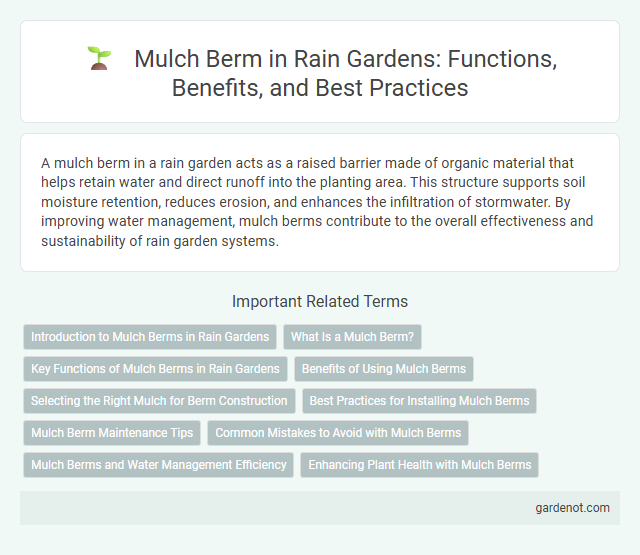A mulch berm in a rain garden acts as a raised barrier made of organic material that helps retain water and direct runoff into the planting area. This structure supports soil moisture retention, reduces erosion, and enhances the infiltration of stormwater. By improving water management, mulch berms contribute to the overall effectiveness and sustainability of rain garden systems.
Introduction to Mulch Berms in Rain Gardens
Mulch berms in rain gardens are strategically placed mounds composed of organic mulch designed to slow runoff and enhance water infiltration. These berms help direct stormwater into the garden, reduce soil erosion, and support plant health by maintaining moisture levels. Incorporating mulch berms optimizes rain garden performance by promoting effective water management and ecological balance.
What Is a Mulch Berm?
A mulch berm is a raised ring or barrier made of organic mulch used in rain gardens to direct and retain water runoff. This structure slows water flow, promotes infiltration, and prevents soil erosion by containing moisture within the garden area. Typically composed of wood chips, bark, or shredded leaves, mulch berms enhance soil health and support plant growth by maintaining consistent moisture levels.
Key Functions of Mulch Berms in Rain Gardens
Mulch berms in rain gardens play a crucial role in controlling water flow and enhancing infiltration by directing runoff toward planting areas. They reduce erosion by stabilizing soil surfaces and trapping sediments during heavy rains. These berms also contribute to moisture retention and create a protective barrier that supports healthy root development in rain garden vegetation.
Benefits of Using Mulch Berms
Mulch berms enhance rain garden efficiency by reducing soil erosion and retaining moisture, creating a stable environment for plant growth. They act as natural barriers that slow water runoff, promoting infiltration and nutrient absorption. By maintaining soil structure and preventing weed growth, mulch berms contribute to healthier vegetation and improved water quality.
Selecting the Right Mulch for Berm Construction
Choosing the right mulch for constructing mulch berms in rain gardens involves prioritizing organic materials like shredded hardwood or bark mulch, which retain moisture and support plant health. Avoiding fine mulches such as sawdust prevents compaction and ensures proper water infiltration in the berm structure. Proper mulch selection enhances erosion control and promotes sustainable rain garden function by maintaining soil stability and nutrient availability.
Best Practices for Installing Mulch Berms
Mulch berms in rain gardens should be installed with a 3 to 6-inch layer of organic mulch such as wood chips or shredded bark to enhance water retention and prevent soil erosion. Creating berms by mounding mulch along the perimeter helps to direct runoff into the garden while allowing proper infiltration. Regular maintenance includes replenishing mulch annually and ensuring the berms remain intact to sustain the rain garden's effectiveness in stormwater management.
Mulch Berm Maintenance Tips
Mulch berm maintenance involves regularly inspecting the berm for any signs of erosion or displacement to ensure it effectively directs water flow. Replenish mulch annually with organic materials such as shredded bark or hardwood chips to retain moisture and suppress weeds, which supports plant health and soil stability. Clear debris and monitor for settled areas that may require reshaping to maintain optimal water absorption and runoff control in the rain garden ecosystem.
Common Mistakes to Avoid with Mulch Berms
Mulch berms around rain gardens often suffer from improper height and placement, leading to water overflow or inadequate filtration. Failing to compact mulch correctly can cause erosion and reduce the berm's effectiveness in directing runoff. Avoid using excessive or insufficient mulch to maintain proper moisture retention and prevent plant stress within the rain garden.
Mulch Berms and Water Management Efficiency
Mulch berms in rain gardens enhance water management efficiency by creating natural barriers that slow runoff and promote infiltration. They reduce soil erosion and help retain moisture, supporting plant health and reducing the need for supplemental irrigation. Properly constructed mulch berms improve the rain garden's capacity to filter pollutants and manage stormwater sustainably.
Enhancing Plant Health with Mulch Berms
Mulch berms improve plant health by retaining soil moisture, reducing evaporation, and regulating soil temperature around rain garden vegetation. These berms also suppress weed growth and prevent soil erosion, creating a stable environment that promotes root development and nutrient absorption. Incorporating organic mulch in berm construction enriches soil quality through gradual decomposition, enhancing overall plant vitality.
Mulch berm Infographic

 gardenot.com
gardenot.com